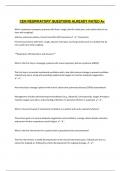CEN RESPIRATORY QUESTIONS ALREADY RATED A+
Which respiratory emergency presents with fever, cough, pleuritic chest pain, and crackles that do not
clear with coughing?
Asthma, pulmonary edema, chronic bronchitis OR Pneumonia ✔️✔️Pneumonia
Pneumonia presents with fever, cough, pleuritic chest pain, and lung sounds (such as crackles) that do
not usually clear with coughing..
**Respiratory CEN Questions and Answers**
What is the first step in managing a patient with acute respiratory distress syndrome (ARDS)?
The first step is to provide mechanical ventilation with a low tidal volume strategy to prevent ventilator-
induced lung injury, along with providing supplemental oxygen to maintain adequate oxygenation.
✔️✔️
How should you manage a patient with chronic obstructive pulmonary disease (COPD) exacerbation?
Management includes administering bronchodilators (e.g., albuterol), corticosteroids, oxygen therapy to
maintain oxygen saturation, and providing antibiotics if a bacterial infection is suspected. ✔️✔️
What is the primary goal of mechanical ventilation in a patient with acute respiratory failure?
The primary goal is to ensure adequate oxygenation and ventilation, manage carbon dioxide retention,
and prevent further respiratory muscle fatigue. ✔️✔️
What is the first intervention for a patient with suspected tension pneumothorax?
The first intervention is needle decompression at the second intercostal space, midclavicular line, to
relieve the trapped air, followed by chest tube placement for ongoing drainage. ✔️✔️
,What are the signs of a pulmonary embolism?
Signs include sudden onset of shortness of breath, chest pain (often pleuritic), tachycardia, hypoxia, and,
in some cases, hemoptysis. A CT pulmonary angiogram is used to confirm the diagnosis. ✔️✔️
How should you manage a patient with asthma experiencing an acute attack?
Management includes administering a short-acting beta agonist (e.g., albuterol) for bronchodilation,
providing oxygen for hypoxia, and corticosteroids to reduce inflammation. If severe, consider
magnesium sulfate or intubation. ✔️✔️
What is the most important intervention for a patient with acute pulmonary edema?
The most important intervention is to provide supplemental oxygen to maintain oxygen saturation,
administer diuretics to reduce fluid overload, and monitor the patient for signs of worsening respiratory
distress. ✔️✔️
What is the first step in managing a patient with a suspected foreign body aspiration?
The first step is to assess the airway for obstruction and perform the Heimlich maneuver if the patient is
unable to cough or breathe. For infants, back blows and chest thrusts should be performed. ✔️✔️
How should you manage a patient with suspected acute respiratory failure due to chronic lung disease?
Management includes ensuring airway protection, providing supplemental oxygen to maintain
saturation, and, if necessary, preparing for non-invasive ventilation (BiPAP or CPAP) or invasive
mechanical ventilation. ✔️✔️
What is the priority assessment in a patient with suspected spontaneous pneumothorax?
, The priority is to assess breath sounds, checking for diminished or absent breath sounds on the affected
side, and monitor for signs of respiratory distress. A chest x-ray or ultrasound is used to confirm the
diagnosis. ✔️✔️
How should you manage a patient with hypercapnic respiratory failure due to COPD?
Management involves administering oxygen cautiously (to avoid further CO2 retention), supporting
ventilation with non-invasive positive pressure ventilation (BiPAP), and monitoring blood gas levels.
✔️✔️
What is the first step in managing a patient with acute respiratory distress and suspected carbon
monoxide poisoning?
The first step is to administer 100% oxygen via non-rebreather mask to eliminate carbon monoxide from
the bloodstream and improve tissue oxygenation. ✔️✔️
How should a nurse assess a patient with suspected pulmonary fibrosis?
The nurse should assess for progressive shortness of breath, a dry cough, and crackles on auscultation.
Pulmonary function tests, a high-resolution CT scan, and biopsy may be necessary for diagnosis. ✔️✔️
What is the management strategy for a patient with a known history of tuberculosis who presents with
hemoptysis?
Management includes isolating the patient in a negative pressure room to prevent the spread of
tuberculosis, obtaining sputum cultures for acid-fast bacilli, and initiating appropriate anti-tuberculosis
therapy. ✔️✔️
What are the most common causes of acute respiratory distress syndrome (ARDS)?
The most common causes of ARDS include trauma, pneumonia, aspiration, sepsis, and inhalation injury.
Management focuses on ventilatory support and treating the underlying cause. ✔️✔️




